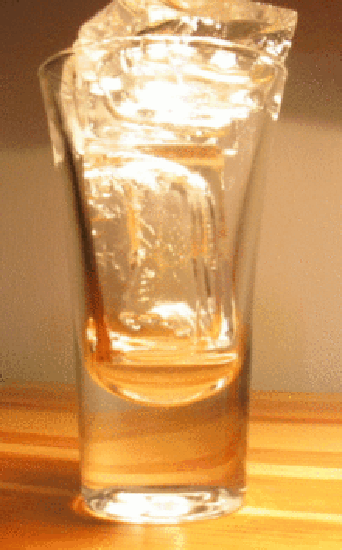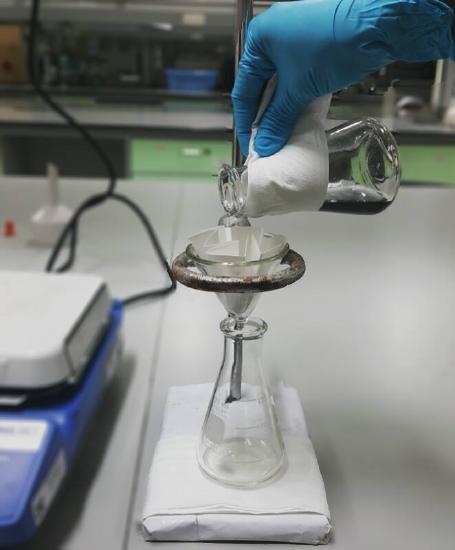What Happens When A Substance Undergoes A Physical Change?
3.vi: Changes in Matter - Concrete and Chemic Changes
- Page ID
- 47460
Learning Objectives
- Label a alter every bit chemical or concrete.
- Listing testify that tin can indicate a chemic modify occurred.
Change is happening all around us all of the time. Merely as chemists have classified elements and compounds, they have likewise classified types of changes. Changes are classified equally either physical or chemical changes. Chemists learn a lot about the nature of matter by studying the changes that matter tin can undergo. Chemists make a distinction between two dissimilar types of changes that they report—physical changes and chemical changes.
Physical Change
Physical changes are changes in which no bonds are cleaved or formed. This means that the same types of compounds or elements that were in that location at the offset of the modify are in that location at the end of the change. Because the ending materials are the same as the commencement materials, the backdrop (such as color, boiling bespeak, etc.) volition also be the same. Concrete changes involve moving molecules around, merely not changing them. Some types of concrete changes include:
- Changes of state (changes from a solid to a liquid or a gas and vice versa).
- Separation of a mixture.
- Physical deformation (cutting, denting, stretching).
- Making solutions (special kinds of mixtures).
As an water ice cube melts, its shape changes every bit information technology acquires the power to period. However, its composition does non change. Melting is an case of a physical change. A physical change is a change to a sample of matter in which some properties of the cloth change, only the identity of the matter does not. When liquid h2o is heated, it changes to water vapor. All the same, even though the physical properties have changed, the molecules are exactly the aforementioned every bit before. We nevertheless have each water molecule containing two hydrogen atoms and 1 oxygen cantlet covalently bonded. When you have a jar containing a mixture of pennies and nickels and yous sort the mixture so that y'all take ane pile of pennies and another pile of nickels, you have not altered the identity of the pennies or the nickels—you've just separated them into two groups. This would be an case of a physical change. Similarly, if you take a slice of paper, you don't change it into something other than a piece of paper past ripping it up. What was paper earlier you started vehement is however newspaper when y'all are done. Over again, this is an example of a concrete alter.

Physical changes can further be classified as reversible or irreversible. The melted ice cube may be refrozen, so melting is a reversible physical alter. Concrete changes that involve a change of state are all reversible. Other changes of state include vaporization (liquid to gas), freezing (liquid to solid), and condensation (gas to liquid). Dissolving is also a reversible concrete change. When common salt is dissolved into water, the salt is said to have entered the aqueous state. The table salt may exist regained past boiling off the h2o, leaving the common salt behind.
Chemical Change
Chemical changes occur when bonds are broken and/or formed betwixt molecules or atoms. This means that i substance with a certain set of properties (such as melting signal, color, taste, etc) is turned into a dissimilar substance with different backdrop. Chemical changes are frequently harder to opposite than physical changes.
One good case of a chemical change is burning a candle. The act of burning paper really results in the formation of new chemicals (carbon dioxide and water) from the burning of the wax. Another example of a chemical change is what occurs when natural gas is burned in your furnace. This time, on the left there is a molecule of methane, \(\ce{CH_4}\), and two molecules of oxygen, \(\ce{O_2}\); on the right are 2 molecules of h2o, \(\ce{H_2O}\), and one molecule of carbon dioxide, \(\ce{CO_2}\). In this case, non only has the appearance inverse, but the structure of the molecules has also changed. The new substances do not have the same chemical properties every bit the original ones. Therefore, this is a chemical change.

We tin can't actually see molecules breaking and forming bonds, although that'due south what defines chemical changes. Nosotros take to make other observations to bespeak that a chemic change has happened. Some of the prove for chemic alter will involve the energy changes that occur in chemical changes, simply some prove involves the fact that new substances with different properties are formed in a chemical change.
Observations that help to indicate chemic change include:
- Temperature changes (either the temperature increases or decreases).
- Low-cal given off.
- Unexpected color changes (a substance with a different color is made, rather than just mixing the original colors together).
- Bubbling are formed (merely the substance is not boiling—you made a substance that is a gas at the temperature of the beginning materials, instead of a liquid).
- Different smell or taste (practise non taste your chemistry experiments, though!).
- A solid forms if 2 clear liquids are mixed (await for floaties—technically chosen a precipitate).
Example \(\PageIndex{1}\)
Label each of the post-obit changes as a physical or chemical change. Give evidence to support your respond.
- Boiling h2o.
- A smash rusting.
- A light-green solution and colorless solution are mixed. The resulting mixture is a solution with a pale green color.
- Ii colorless solutions are mixed. The resulting mixture has a xanthous precipitate.
Solution
- Concrete: humid and melting are concrete changes. When water boils, no bonds are broken or formed. The change could exist written: \(\ce{H_2O} \left( l \correct) \rightarrow \ce{H_2O} \left( one thousand \right)\)
- Chemic: The dark gray nail changes color to form an orangish flaky substance (the rust); this must be a chemical change. Color changes signal chemical modify. The following reaction occurs: \(\ce{Fe} + \ce{O_2} \rightarrow \ce{Fe_2O_3}\)
- Physical: because none of the backdrop changed, this is a physical alter. The green mixture is still green and the colorless solution is even so colorless. They have just been spread together. No color alter occurred or other evidence of chemical change.
- Chemic: the formation of a precipitate and the color change from colorless to yellowish indicate a chemical change.
Practice \(\PageIndex{1}\)
Label each of the following changes as a physical or chemic change.
- A mirror is broken.
- An fe blast corroded in moist air
- Copper metal is melted.
- A catalytic converter changes nitrogen dioxide to nitrogen gas and oxygen gas.
- Answer a:
- physical change
- Reply b:
- chemical modify
- Answer c:
- physical change
- Reply d:
- chemical change
Separating Mixtures Through Physical Changes
Homogeneous mixtures (solutions) tin can be separated into their component substances by concrete processes that rely on differences in some physical belongings, such as differences in their boiling points. Two of these separation methods are distillation and crystallization. Distillation makes use of differences in volatility, a measure of how hands a substance is converted to a gas at a given temperature. A simple distillation apparatus for separating a mixture of substances, at least one of which is a liquid. The near volatile component boils first and is condensed back to a liquid in the water-cooled condenser, from which information technology flows into the receiving flask. If a solution of common salt and water is distilled, for example, the more volatile component, pure water, collects in the receiving flask, while the common salt remains in the distillation flask.

Mixtures of two or more than liquids with dissimilar boiling points can be separated with a more complex distillation appliance. 1 instance is the refining of crude petroleum into a range of useful products: aviation fuel, gasoline, kerosene, diesel fuel, and lubricating oil (in the approximate lodge of decreasing volatility). Another example is the distillation of alcoholic spirits such as brandy or whiskey. This relatively simple process caused more than a few headaches for federal authorities in the 1920s during the era of Prohibition, when illegal stills proliferated in remote regions of the Us.
Another example for using physical properties to dissever mixtures is filtration (Figure \(\PageIndex{iv}\)). Filtration is any mechanical, physical or biological performance that separates solids from fluids (liquids or gases) by adding a medium through which just the fluid can pass. The fluid that passes through is called the filtrate. There are many different methods of filtration; all aim to attain the separation of substances. Separation is achieved by some class of interaction betwixt the substance or objects to be removed and the filter. The substance that is to pass through the filter must be a fluid, i.due east. a liquid or gas. Methods of filtration vary depending on the location of the targeted fabric, i.e. whether information technology is dissolved in the fluid phase or suspended as a solid.

Summary
- Chemists brand a distinction between 2 dissimilar types of changes that they study—physical changes and chemical changes.
- Physical changes are changes that do non change the identity of a substance.
- Chemical changes are changes that occur when one substance is turned into another substance.
- Chemical changes are frequently harder to contrary than physical changes. Observations that indicate a chemical change has occurred include color alter, temperature change, light given off, formation of bubbles, formation of a precipitate, etc.
Contributions & Attributions
This page was synthetic from content via the post-obit contributor(s) and edited (topically or extensively) by the LibreTexts development team to meet platform style, presentation, and quality:
-
Boundless (world wide web.dizzying.com)
-
Marisa Alviar-Agnew (Sacramento Metropolis Higher)
-
Henry Agnew (UC Davis)
Source: https://chem.libretexts.org/Bookshelves/Introductory_Chemistry/Map%3A_Introductory_Chemistry_(Tro)/03%3A_Matter_and_Energy/3.06%3A_Changes_in_Matter_-_Physical_and_Chemical_Changes
Posted by: cardenwred1954.blogspot.com


0 Response to "What Happens When A Substance Undergoes A Physical Change?"
Post a Comment